FILE - In this Sept. 17, 2015 file photo, Saudi security forces take part in a military parade in preparation for the annual Hajj pilgrimage in Mecca, Saudi Arabia. Global military spending rose in 2015 to nearly $1.7 trillion, the first increase in several years, driven by conflicts including the battle against the Islamic State group, the Saudi-led war in Yemen and fears about Iran, a report released Tuesday, April 5, 2016 shows. (AP Photo/Mosa'ab Elshamy, File)
The Associated Press
DUBAI, United Arab Emirates (AP) - Global military spending rose in 2015 to nearly $1.7 trillion, the first increase in several years, driven by conflicts including the battle against the Islamic State group, the Saudi-led war in Yemen and fears about Iran, a report released Tuesday shows.
The study by the Stockholm International Peace Research Institute also noted that the Chinese expansion in the South China Sea and Russia's annexation of Crimea and support of Ukrainian separatists also accounted for nudging spending up 1 percent in real terms, compared to 2014.
For weapons manufacturers, the nonstop pace of airstrikes targeting Islamic State fighters in Iraq and Syria, as well as Saudi-led bombing of Yemen's Shiite rebels and their allies, means billions of dollars more in sales.
But activists question continued U.S. arms deals to Saudi Arabia as its Yemen campaign has killed civilians, while American fighter jet sales to both emerging military buyer Qatar and longtime ally Kuwait appear stalled.
The United States, with $596 billion in defense spending, and China, with an estimated $215 billion, led all countries in 2015, the annual report by SIPRI said. Saudi Arabia, however, came in third with spending of $87.2 billion - double what it spent in 2006, according to the report. That fueled the first worldwide increase in military spending since 2011.
Iraq spent $13.1 billion on its military in 2015, up well over 500 percent from 2006 as it has rebuilt its armed forces following the U.S. withdrawal and rise of the Islamic State group, SIPRI said.
While part of the U.S. coalition fighting the extremists, Saudi Arabia also launched a war in Yemen in March 2015 to support the country's internationally recognized government after Shiite rebels known as Houthis earlier overran the country's capital, Sanaa. The Sunni kingdom views the Houthis as a proxy of Shiite power Iran, long its regional rival.
The United Arab Emirates also is taking part in both conflicts and likely has spent billions of dollars to support its military in 2015 as well, though the Stockholm-based institute said it couldn't offer precise figures this year, senior research Pieter Wezeman said. Both the UAE and Saudi Arabia also sent troops into Bahrain to put down its 2011 Arab Spring-inspired protests.
"This clearly is a reason for these countries to improve their so-called security forces, both to be able to fight against internal uprisings, whether a more-peaceful nature or more violent, but also of course to intervene in neighboring countries," Wezeman, who took part in the report, told The Associated Press.
But the air campaign waged by the Saudi-led, U.S.-backed coalition in Yemen has been increasingly criticized by human rights activists over civilian deaths. Airstrikes account for 60 percent of the 3,200 civilians killed in the conflict, according to the United Nations, which has criticized coalition strikes that have hit markets, clinics and hospitals.
Yet arms deals continue, especially from the U.S. Asked about the civilian casualties, State Department spokesman David McKeeby said the United States remained "deeply concerned by the devastating toll of the crisis in Yemen."
"We have remained in regular contact with the Saudi-led coalition and have reinforced to them the need to avoid civilian casualties and the importance of precise targeting," McKeeby said in a statement. "We have encouraged them to investigate all credible accounts of civilian casualties as a result of coalition strikes - and to report publicly the results of these investigations."
But both the Yemen war and the fight against the Islamic State group likely will keep arms manufacturers busy into 2016. Companies that may see increased sales include Boeing. Co., General Dynamics, Lockheed Martin Corp. and Raytheon Co., aerospace and defense analyst Roman Schweizer at Guggenheim Securities wrote March 28.
"We have been bullish for the better part of a year that the Pentagon and its European and (Gulf) allies will have to refill their stocks of missiles and munitions due to the current campaign against ISIS in Iraq, Syria, Yemen and even Libya," Schweizer wrote, using an alternate acronym for the extremist group.
Meanwhile, President Barack Obama promised America's "ironclad commitment" to back its Gulf allies during a summit last May. In the time since, the U.S. has made $33 billion in arms sales to its Gulf allies, including an $11.25-billion deal with Saudi Arabia that includes four armed warships to modernize its navy, McKeeby said.
But the Obama administration has been criticized by U.S. Sen. John McCain, an Arizona Republican, for "failing to live to up the promises" made at the summit by allegedly stalling fighter jet sales to both Kuwait and Qatar.
"They are languishing on the shelf gathering dust," McCain said at a hearing on March 8. Tiny Qatar in the meantime has signed a deal for 6.7 billion euros ($7.6 billion) to buy 24 Dassault Rafal fighter jets from France.
Obama will visit Saudi Arabia on April 21 for a meeting of the Gulf Cooperation Council, which includes Saudi Arabia, Bahrain, Kuwait, Oman, Qatar and the UAE. The jet sales likely will be a topic of discussion, as will Iran after its recently implemented nuclear deal with world powers.
Wezeman said international sanctions against Iran had seen its weapons technology lag behind its neighbors as its military spending dropped by 30 percent between 2006 and 2015. However, he acknowledged regional suspicions likely would keep Gulf military spending strong.
"Iran is, of course, perceived as an adversary and also wants to be the main player in the region, a country which will potentially use its influence over different proxy groups in the region to destabilize countries," Wezeman said. "Both the expenditure and the armament procurement by states in the Gulf are clearly aimed at kind of keeping Iran in check."
___
Online:
Stockholm International Peace Research Institute: www.sipri.org
___
Follow Jon Gambrell on Twitter at www.twitter.com/jongambrellap . His work can be found at http://bigstory.ap.org/content/jon-gambrell .
FILE - In this Oct. 20, 2014 file photo, thick smoke and flames erupt from an airstrike by the U.S.-led coalition in Kobani, Syria, as seen from a hilltop on the outskirts of Suruc, at the Turkey-Syria border. For weapons manufacturers, the nonstop pace of airstrikes targeting Islamic State fighters in Iraq and Syria, as well as Saudi-led bombing of Yemenâs Shiite rebels and their allies, means billions of dollars in more sales according to a report released by the Stockholm International Peace Research Institute on Tuesday, April 5, 2016.(AP Photo/Lefteris Pitarakis, File)
The Associated Press
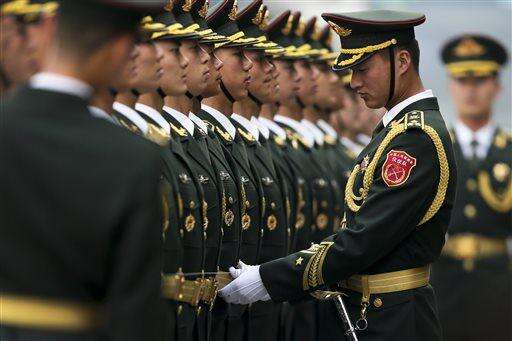
FILE - In this March 21, 2016, file photo, a Chinese People's Liberation Army soldier checks a line of an honor guard as they prepare for a welcome ceremony for visiting German President Joachim Gauck outside the Great Hall of the People in Beijing. The United States, with $596 billion in defense spending, and China, with an estimated $215 billion, led all countries in 2015, the annual report released Tuesday, April 5, 2016, by Stockholm International Peace Research Institute said. Saudi Arabia, however, came in third with spending of $87.2 billion _ double what it spent in 2006, according to the report. That fueled the first worldwide increase in military spending since 2011. (AP Photo/Andy Wong, File)
The Associated Press
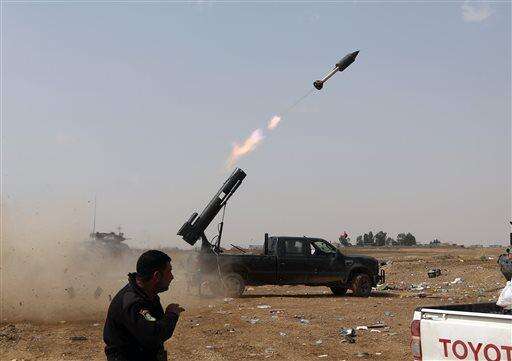
FILE - In this March 30, 2015, file photo, Iraqi security forces launch a rocket against Islamic State extremist positions during clashes in Tikrit, 130 kilometers (80 miles) north of Baghdad, Iraq. According to a new report released Tuesday, April 5, 2016, Iraq spent $13.1 billion on its military in 2015, up well over 500 percent from 2006 as it has rebuilt its armed forces following the U.S. withdrawal and rise of the Islamic State group, the Stockholm International Peace Research Institute said. (AP Photo/Khalid Mohammed, File)
The Associated Press
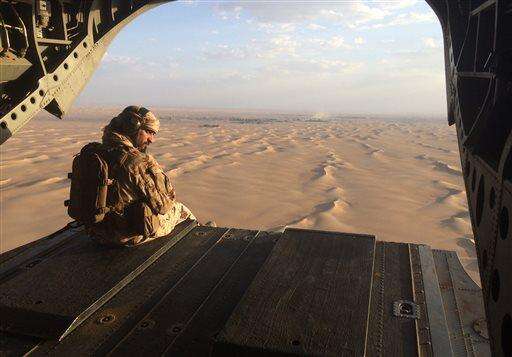
FILE - In this Sept. 17, 2015 photo, an Emirati gunner watches for enemy fire from the rear gate of a United Arab Emirates Chinook military helicopter flying over Yemen. The United Arab Emirates is taking part in regional conflicts and likely has spent into the billions of dollars to support its military in 2015 as well, a new report revealed. Both the UAE and Saudi Arabia also sent troops into Bahrain to put down its 2011 Arab Spring-inspired protests. (AP Photo/Adam Schreck, File)
The Associated Press
FILE - In this Aug. 10, 2014, file photo, an aircraft lands after missions targeting the Islamic State group in Iraq from the deck of the U.S. Navy aircraft carrier USS George H.W. Bush in the Persian Gulf. For weapons manufacturers, the nonstop pace of airstrikes targeting Islamic State fighters in Iraq and Syria, as well as Saudi-led bombing of Yemenâs Shiite rebels and their allies, means billions of dollars more in sales. (AP Photo/Hasan Jamali, File)
The Associated Press
FILE - In this Feb. 11, 2015, file photo, Navy cadets march during a rehearsal for the Victory Day military parade at the Neva River embankment in St. Petersburg, Russia. The study by the Stockholm International Peace Research Institute also noted that the Chinese expansion in the South China Sea and Russiaâs annexation of Crimea and support of Ukrainian separatists also accounted for nudging spending up 1 percent in real terms, compared to 2014. (AP Photo/Dmitry Lovetsky, File)
The Associated Press
FILE - In this March 4, 2016, file photo, delegates from the Chinese People's Liberation Army (PLA) leave the Great Hall of the People in Beijing. A report by The Stockholm International Peace Research Institute revealed that the U.S. with $596 billion in defense spending and China with an estimated $215 billion led all countries in military spending in 2015. (AP Photo/Mark Schiefelbein, File)
The Associated Press
FILE - In this Monday, March 30, 2015 photo, an Iraqi soldier searches a for fighters of Islamic State group in Tikrit, 80 miles (130 kilometers) north of Baghdad, Iraq. Iraq spent $13.1 billion on its military in 2015, up well over 500 percent from 2006 as it has rebuilt its armed forces following the U.S. withdrawal and rise of the Islamic State group, SIPRI said. (AP Photo/Khalid Mohammed, File)
The Associated Press
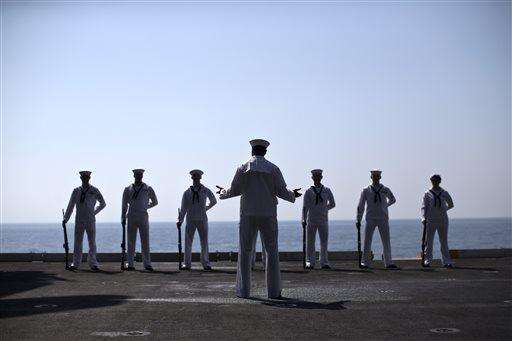
FILE - In this Sept. 11, 2015 photo, U.S. Navy sailors wear full dress white uniforms before a Sept. 11 remembrance ceremony on board the USS Theodore Roosevelt aircraft carrier deployed in the Persian Gulf in support of Operation Inherent Resolve, the military operation against Islamic State extremists in Syria and Iraq. Global military spending rose in 2015 to nearly $1.7 trillion, the first increase in several years, driven by conflicts including the battle against the Islamic State group, the Saudi-led war in Yemen and fears about Iran, a report released Tuesday, April 5, 2016, shows. (AP Photo/Marko Drobnjakovic, File)
The Associated Press
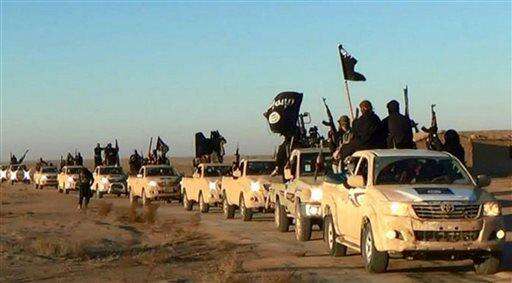
FILE - In this undated file photo released online in the summer of 2014 on a militant social media account, which has been verified and is consistent with other AP reporting, militants of the Islamic State group hold up their weapons and wave its flags on their vehicles in a convoy on a road leading to Iraq, in Raqqa, Syria. Both the Yemen war and the fight against the Islamic State group likely will keep arms manufacturers busy into 2016. Companies that may see increased sales include Boeing. Co., General Dynamics, Lockheed Martin Corp. and Raytheon Co., aerospace and defense analyst Roman Schweizer at Guggenheim Securities wrote March 28, 2016. (Militant photo via AP, File)
The Associated Press
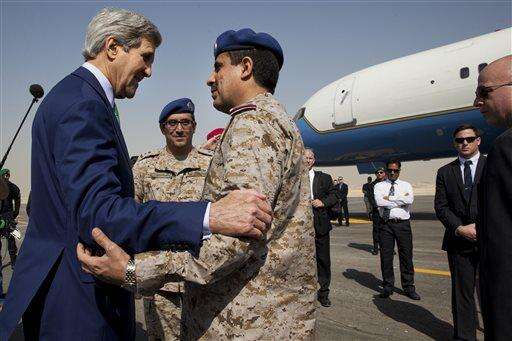
FILE - In this Jan. 24, 2016, photo, U.S. Secretary of State John Kerry says goodbye to Saudi Arabian military personnel as he leaves Riyadh, Saudi Arabia, en route to Vientiane, Laos. President Barack Obama promised Americaâs "ironclad commitment" to back its Gulf allies during a summit last May. In the time since, the U.S. has made $33 billion in arms sales to its Gulf allies, including an $11.25-billion deal with Saudi Arabia that includes four armed warships to modernize its navy, State Department spokesman David McKeeby said. (AP Photo/Jacquelyn Martin, Pool, File)
The Associated Press
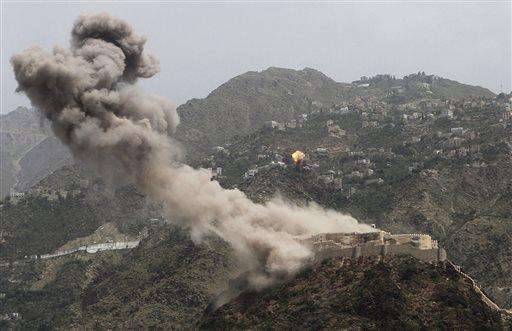
FILE - In this May 21, 2015, photo, smoke rises from al-Qahira castle, an ancient fortress that was recently taken over by Shiite rebels, as another building on the Saber mountain, in the background, explodes after Saudi-led air strikes in Taiz city, Yemen. The the air campaign waged by the Saudi-led, U.S.-backed coalition in Yemen has been increasingly criticized by human rights activists over civilian deaths. Yet arms deals continue, especially from the U.S. (AP Photo/Abdulnasser Alseddik, File)
The Associated Press
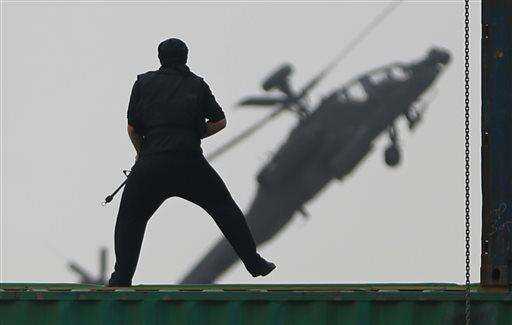
FILE- In this Feb. 22, 2015, file photo, United Arab Emirates armed forces demonstrate during a military show at the opening ceremony of the International Defence Exhibition and Conference, IDEX, in Abu Dhabi, United Arab Emirates. Global military spending rose in 2015 to nearly $1.7 trillion, the first increase in several years, driven by conflicts including the battle against the Islamic State group, the Saudi-led war in Yemen and fears about Iran, a report released Tuesday, April 5, 2016, shows. (AP Photo/Kamran Jebreili, File)
The Associated Press
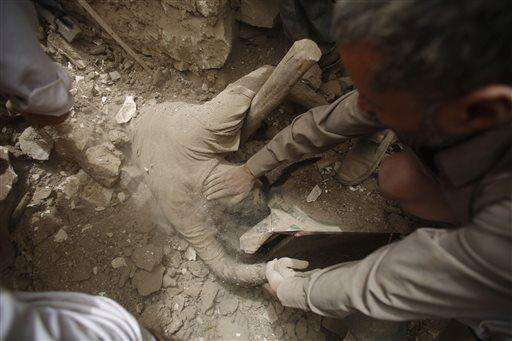
FILE - In this June 12, 2015 photo, people uncover the body of a man from under the rubble of houses destroyed by Saudi airstrikes in the old city of Sanaa, Yemen. The air campaign waged by the Saudi-led, U.S.-backed coalition in Yemen has been increasingly criticized by human rights activists over civilian deaths. Airstrikes account for 60 percent of the 3,200 civilians killed in the conflict, according to the United Nations, which has criticized coalition strikes that hit markets, clinics and hospitals. (AP Photo/Hani Mohammed, File)
The Associated Press
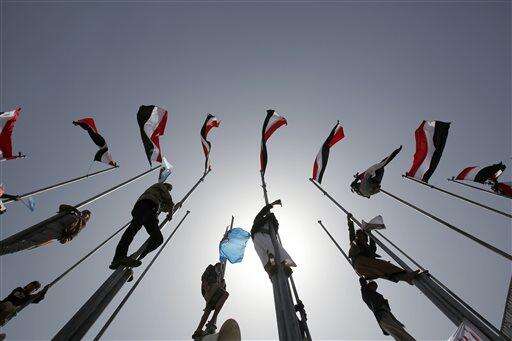
FILE - In this Saturday, March 26, 2016 photo, supporters of Yemen's former President Ali Abdullah Saleh, who are allies of Shiite rebels known as Houthis, climb flag poles during a rally to mark the first anniversary of the Saudi-led military campaign against them, in Sanaa, Yemen. While part of the U.S. coalition fighting the extremists, Saudi Arabia also launched a war in Yemen in March 2015 to support the countryâs internationally recognized government after Shiite rebels known as Houthis earlier overran the countryâs capital, Sanaa. The Sunni kingdom views the Houthis as a proxy of Shiite power Iran, long its regional rival. (AP Photo/Hani Mohammed, File)
The Associated Press